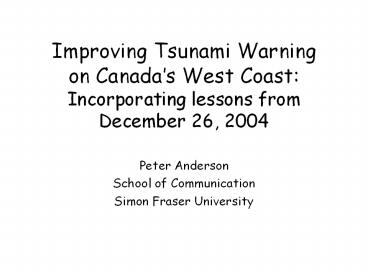Improving Tsunami Warning on Canada PowerPoint PPT Presentation
1 / 60
Title: Improving Tsunami Warning on Canada
1
Improving Tsunami Warning on Canadas West
CoastIncorporating lessons from December 26,
2004
- Peter Anderson
- School of Communication
- Simon Fraser University
2
Causes of Tsunamis
- Large wave events generated by large surface
impacts or sudden ocean floor movements that
displace large volumes of water. - Usually associated with earthquakes
- Can also be triggered by
- submarine or terrestrial landslides
- submarine and terrestrial volcanic eruptions
(e.g., Krakatoa 1883) - explosions (e.g., Halifax Harbour 1917)
- bolide impacts (e.g. asteroid, meteor, comet)
3
SourceClague, 2001
4
Source http//www.pgc.nrcan.gc.ca/seismo/mstrec/l
ocal/28Feb01-info.htm
http//www.noaanews.noaa.gov/stories2005/images/ts
unami-dart-system.jpg
5
Applying Lessons from December 26, 2005Tsunami
6
Source http//www.pmel.noaa.gov/tsunami/indo_1204
.html
7
Sri Lanka
8
(No Transcript)
9
(No Transcript)
10
714 AM PTWS Issues Earthquake Bulletin 8.0 mag.
11
(No Transcript)
12
804 AM PTWS Issues Earthquake Bulletin update
8.5 mag.
13
10,500 DEAD
14
23,000 DEAD
855 AM Tsunami hits Trinco and Batticaloa
15
31,000 DEAD
930AM-1255PM Tsunami Hits Galle, Kalutara and
more
16
(No Transcript)
17
(No Transcript)
18
(No Transcript)
19
(No Transcript)
20
(No Transcript)
21
(No Transcript)
22
(No Transcript)
23
Sri Lanka Tsunami Impacts(February 24, 2005)
24
Sri Lanka Tsunami Impacts(February 24, 2005)
25
Lessons
26
Warning must be viewed as part of an integrated
system and not simply a technology
27
Warning System Stages
- Detection and notification
- Emergency management system
- Local dissemination
28
(No Transcript)
29
Warning Sub-system Components
- Hazard identification, risk assessment and
vulnerability analysis - Detection and monitoring
- Deciding to issue a warning
- Framing the warning
- Targeting and disseminating the warning
- Disseminating the warning
- Receiving and understanding the warning
- Validating the warning
- Taking appropriate action
- Feedback to assess impacts
30
Any system is only as effective as its weakest
link
31
Contributors to Warning System Failures
- Failure of forecasting/detection
- Ignorance of prevailing conditions of
vulnerability - Failure of warning system infrastructure
- Failure to communicate the threat accurately or
in sufficient time - Failure to understand the warning
- Constrained capacity of the government or
community to respond
32
Tsunami Risk and Warning in British Columbia
33
Source Clague 2001
34
(No Transcript)
35
Courtesy John Clague, SFU
36
Tsunami Impacts from 1964 9.2 Alaskan Earthquake
37
(No Transcript)
38
Courtesy British Columbia Provincial Emergency
Program
39
Courtesy British Columbia Provincial Emergency
Program
40
Courtesy British Columbia Provincial Emergency
Program
41
B.C. Tsunami Warning System Components
42
Source NOAA http//wcatwc.arh.noaa.gov/web_tsus/1
7371016/traveltime.gif
43
Stage 2 Components
PSEPC
Source British Columbia Tsunami Warning and
Alerting Plan
44
Source British Columbia Tsunami Warning and
Alerting Plan
45
Special Challenges for British Columbia
46
Current West Coast Tsunami Warning System
- Most effective in the case of far-field or
telegenic tsunamis - Not designed for locally generated tsunamis
47
Coastal Socio-economic Considerations
48
(Source Clague et al., 1999)
49
(No Transcript)
50
(No Transcript)
51
(No Transcript)
52
(No Transcript)
53
Canadian West CoastTsunami Warning System
Limitations
- Coverage community
- Coverage - terrain
- Coverage transient populations
- Means of communication and warning
- Community and industry preparedness
- Public education and awareness
54
Observations About Infrastructure
- No single technology can facilitate the effective
delivery of warnings. - One method will not reach all and a strategy is
needed to integrate and support multiple methods
and channels to disseminate messages. - By adopting common standards for information
formatting and telecommunications interfaces
warning systems should be flexible enough to
adapt to different information delivery systems.
55
Observations about Warning
- The tsunami warning phase contains a limited
window of opportunity to capture public attention
and encourage appropriate action. - Appropriate response to warnings is most likely
to occur when people have been educated about the
hazard well before the warning.
56
Effective Warning Prerequisites
- Planning
- Education
- Testing and evaluation
57
Selected Recommendationsfrom SFU Study
- Tsunami risk is site specific.
- Inundation and risk mapping activities should be
expanded to include all populated and important
economic coastal areas at risk in B.C. - A communications infrastructure audit needs to be
undertaken to identify local capabilities and
specific gaps in coverage.
58
Selected Recommendationsfrom SFU Study
- Local authorities need to work together to
develop a common public educational outreach
program to ensure that local residents and
businesses understand the procedures associated
with tsunami watch and warning bulletins. - Continued support from federal and provincial
agencies and expanded access to tsunami
information.
59
Post Assessment Report Developments
- Tsunami Integrated Preparedness Project
- Joint federal/provincial initiative 1.85 M.
- to identify risks, develop enhanced response
plans, upgrade communications and warning
systems, and support public education programs.
60
Additional Information Sources
- BC PEP Tsunami Warning and Alerting Plan
http//www.pep.bc.ca/hazard_plans/tsunami2001/Tsun
ami_Warning_and_Alerting_Plan-2001.pdf - Clague, John. Clague, J.J. (2001) Tsunamis, in A
Synthesis of Geological Hazards in Canada. G.R.
Brooks (editor) Geological Survey of Canada,
Bulletin 548, p.27-42. - Clague, John J., Munro, Adam, and Murty, Tad.
(2003) Tsunami Hazard and Risk in Canada, Natural
Hazards, 28 433-461 - SFU/PSEPC Report An Assessment of the B.C.
Tsunami Warning System and Related Risk Reduction
Practices - http//www.ocipep.gc.ca/research/resactivites/CI/
2003-D001_e.asp - Tsunami Integrated Preparedness Project
http//www.pep.bc.ca

